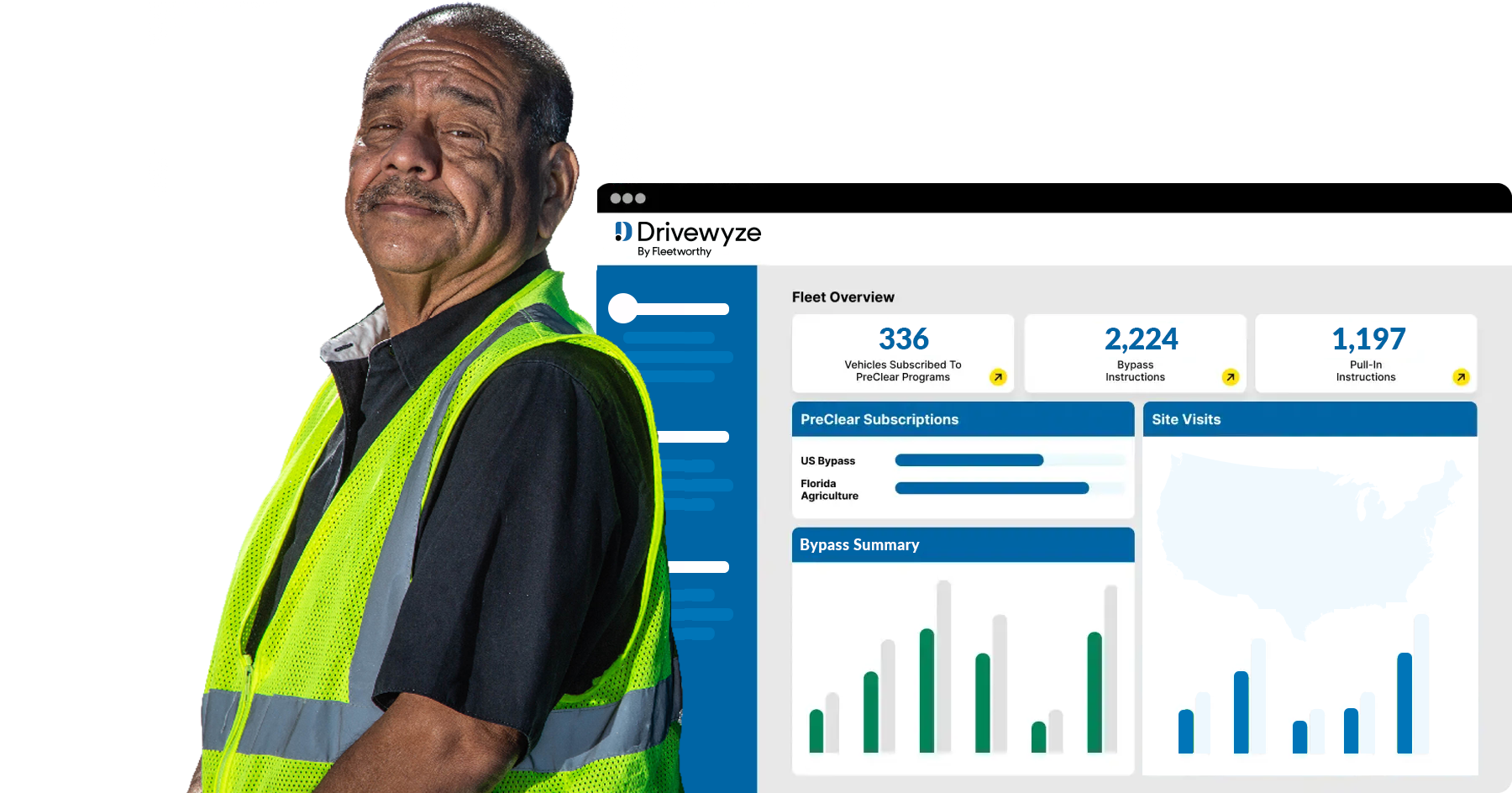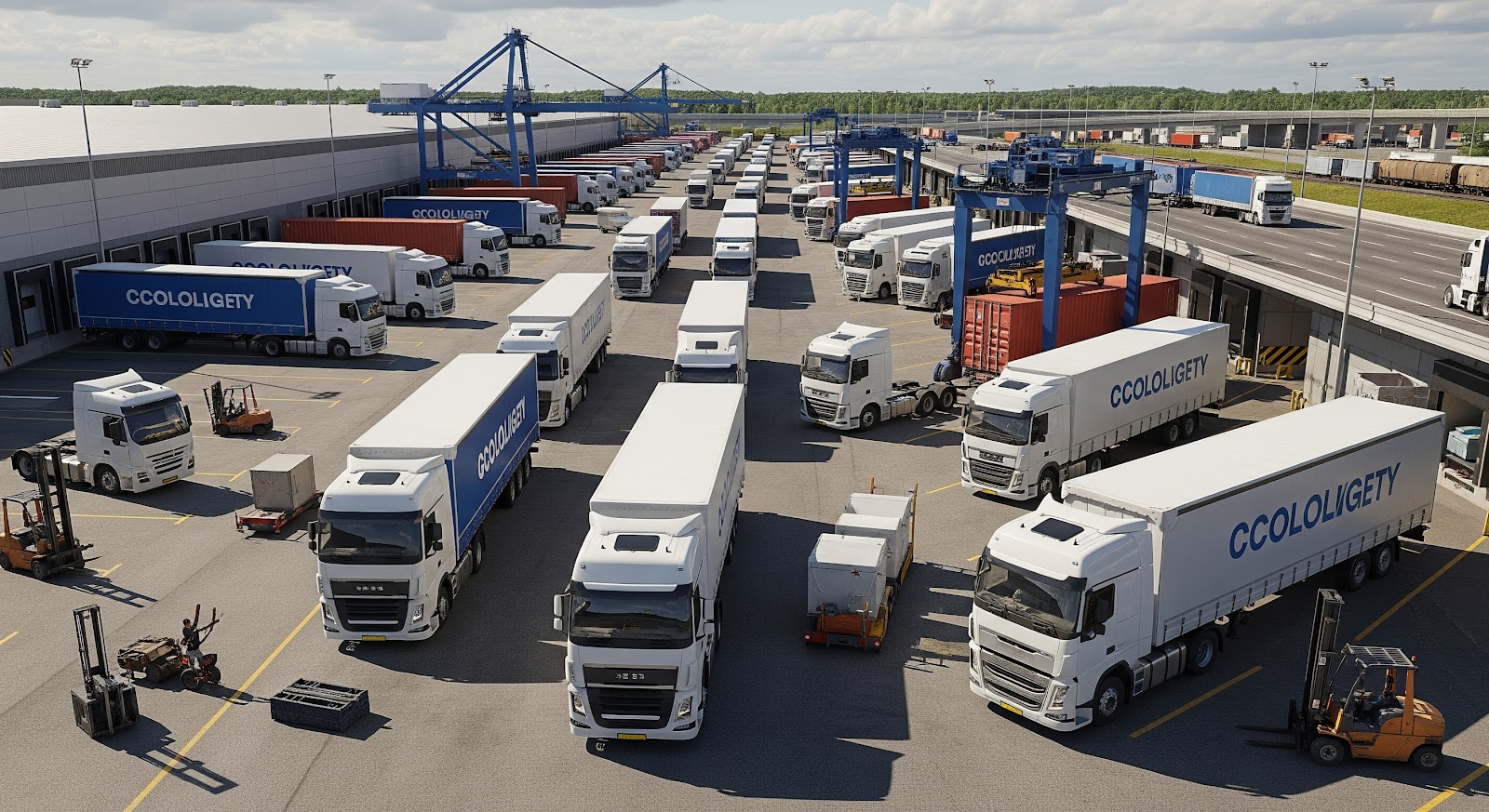Safety isn’t just a goal in commercial transportation—it’s a regulatory imperative. At the center of this effort is the Federal Motor Carrier Safety Administration (FMCSA), the primary government agency tasked with reducing crashes, injuries, and fatalities involving large trucks and buses on U.S. roadways.
The FMCSA plays a pivotal role in shaping the safety and compliance landscape for fleets of all sizes. Through its regulations, enforcement programs, and data-driven initiatives, the agency establishes the standards that guide commercial vehicle operations—from how long drivers can be on the road to the systems fleets must use to log data and report inspections.
Key responsibilities of the FMCSA include:
- Developing safety regulations for commercial motor vehicles (CMVs), including Hours of Service (HOS), vehicle maintenance, drug and alcohol testing, and driver qualification standards.
- Administering the Compliance, Safety, Accountability (CSA) program, which scores fleets based on safety performance, violations, and crash history.
- Conducting audits, inspections, and investigations to ensure carriers meet federal safety standards.
- Implementing technology-driven compliance systems, such as the ELD mandate and roadside e-inspection pilots, to streamline oversight and improve accountability.
This guide is designed to help fleets not only understand these complex requirements but build a proactive, tech-enabled compliance strategy that keeps drivers safe and operations running smoothly. Whether you’re a safety manager at a national fleet or an independent carrier, understanding the FMCSA’s role is your first step toward a stronger safety culture.
Understanding FMCSA Compliance: The Foundations
Staying compliant with federal safety regulations starts with understanding the scope and authority of the Federal Motor Carrier Safety Administration. As the central regulatory body overseeing commercial motor vehicle safety in the United States, the FMCSA’s mission is simple but vital: to reduce crashes, injuries, and fatalities involving large trucks and buses.
To achieve that mission, the agency develops and enforces a comprehensive framework of rules that govern the people, vehicles, and companies operating within the transportation industry. These regulations aren’t just about checking boxes—they are foundational to protecting drivers, freight, and the public.
FMCSA’s Mission and Authority
The FMCSA operates under the U.S. Department of Transportation (DOT), with broad authority to:
- Establish and enforce safety regulations for motor carriers
- Conduct roadside inspections and audits
- Set minimum qualifications for drivers and fleet operators
- Collect and analyze crash and compliance data to inform policy and enforcement
- Promote safety innovations and compliance technologies
For fleets, this means that compliance with FMCSA regulations is not only mandatory—but critical to business continuity, insurance eligibility, and overall fleet reputation.
Key FMCSA Regulations Every Fleet Must Know
1. Hours of Service
Designed to combat driver fatigue, HOS rules dictate how long a driver can be on duty and behind the wheel before taking mandatory rest breaks. Core rules include:
- 11-hour driving limit within a 14-hour window
- 10 consecutive hours off-duty between shifts
- 30-minute break after 8 hours of driving
- 60/70-hour on-duty limits over 7/8 consecutive days
Failure to comply can lead to serious penalties, audit triggers, and increased crash risk.
2. Driver Qualification Files
FMCSA requires motor carriers to maintain a Driver Qualification File for each driver operating a commercial vehicle. This file must include:
- A valid and current Motor Vehicle Record
- Proof of valid Commercial Driver’s License
- Medical examiner’s certificate
- Road test certification or equivalent
- Annual reviews and updates
Incomplete or outdated DQFs are among the most common audit violations and can put carriers out of service.
3. Vehicle Maintenance and Inspections
Fleets must perform routine inspections, repairs, and maintenance on all CMVs. Requirements include:
- Pre-trip and post-trip driver inspections
- Annual inspections by qualified personnel
- Proper documentation and recordkeeping for repairs
- Ensuring that vehicles meet minimum mechanical standards
Unaddressed maintenance issues not only violate FMCSA rules—they directly contribute to preventable breakdowns and crashes.
4. Drug & Alcohol Testing
To promote a drug-free trucking industry, FMCSA enforces strict drug and alcohol testing protocols for CDL drivers. Carriers must:
- Conduct pre-employment testing
- Administer random, post-accident, reasonable suspicion, and return-to-duty tests
- Use DOT-approved labs and testing procedures
- Maintain accurate and secure records
Non-compliance puts drivers and the public at risk and can lead to severe enforcement actions.
5. Electronic Logging Device (ELD) Mandate
The ELD rule requires most commercial drivers to use electronic logging devices to track HOS. ELDs automatically record:
- Driving time
- Engine hours
- Vehicle movement
- Location
- Duty status changes
Fleets must ensure ELDs are FMCSA-registered, properly installed, and used in accordance with the rule. Tampering or misuse can lead to substantial penalties and lost business opportunities.
The Compliance, Safety, Accountability Program Explained
The CSA program is FMCSA’s data-driven safety compliance and enforcement initiative. It evaluates motor carriers and drivers using performance data in several categories—known as BASICs (Behavior Analysis and Safety Improvement Categories):
- Unsafe Driving
- Crash Indicator
- Hours-of-Service Compliance
- Vehicle Maintenance
- Controlled Substances and Alcohol
- Hazardous Materials Compliance
- Driver Fitness
Carriers are assigned scores based on roadside inspections, violations, and crash records. High scores can trigger DOT audits, higher insurance premiums, and limited business opportunities with shippers and brokers.
Drivewyze can play a strategic role in helping fleets manage CSA scores by reducing violations, improving driver awareness, and offering data that supports proactive safety and compliance initiatives.

Common Compliance Pitfalls (And How to Avoid Them)
Even the most safety-conscious fleets can fall into compliance traps—often due to administrative oversights, outdated systems, or breakdowns in communication. Unfortunately, these issues can result in costly violations, increased CSA scores, and even out-of-service orders.
Below are some of the most common FMCSA compliance pitfalls—and practical strategies to avoid them.
1. Incomplete or Outdated Driver Qualification Records
The Risk:
Driver Qualification Files (DQFs) are required for every CDL driver and must be kept accurate and up to date. Missing documents like expired medical cards, outdated Motor Vehicle Records, or incomplete employment history can lead to automatic violations during audits.
How to Avoid It:
- Create a centralized digital DQF management system.
- Set automated reminders for expiring documents and required annual reviews.
- Conduct internal audits at least quarterly to ensure file completeness.
- Use onboarding checklists to standardize the collection of all required documents.
Pro tip: Assign compliance ownership to a specific team member to ensure accountability.
2. Inaccurate HOS Logs and ELD Violations
The Risk:
Errors in Hours of Service logging—whether accidental or intentional—are among the most frequently cited violations. Improper use of ELDs, including manual edits, missed logins, or driving without logging in, can trigger FMCSA audits and result in penalties.
How to Avoid It:
- Train drivers on proper ELD use and log editing protocols.
- Choose FMCSA-certified ELDs with user-friendly interfaces.
- Monitor real-time HOS data to flag anomalies and intervene early.
- Perform regular back-office reviews of log accuracy and duty status changes.
Did you know?
The majority of HOS violations can be traced back to simple user errors that can be fixed through routine training and monitoring.
3. Missed or Improperly Documented Vehicle Inspections
The Risk:
Failure to complete or document pre-trip, post-trip, or periodic inspections is a major red flag for DOT officers. It signals a potential lack of maintenance oversight and increases the likelihood of mechanical issues on the road.
How to Avoid It:
- Standardize inspection procedures and checklists across your fleet.
- Use digital tools or apps to simplify documentation and reporting.
- Track inspection completion and follow-up repairs in a centralized system.
- Review inspection data regularly to catch trends or recurring issues.
A missed tire tread check today can lead to a roadside violation—and an avoidable blowout—tomorrow.
4. Insufficient Safety Training Programs
The Risk:
Many fleets focus on operational training while neglecting ongoing safety education. Without consistent reinforcement, drivers may fall out of compliance or develop unsafe habits that increase accident and inspection risks.
How to Avoid It:
- Implement a structured safety training program with regular refreshers.
- Tailor content to cover evolving FMCSA regulations, real-world scenarios, and seasonal hazards.
- Use training performance data to identify coaching opportunities.
- Reward and recognize safety-focused behavior to reinforce positive habits.
Safety is not a one-time event—it’s an ongoing investment in your fleet’s culture and performance.
5. Failing to Act on Safety Alerts and Driver Behavior Data
The Risk:
Ignoring unsafe driving behavior—like speeding, hard braking, or roll stability events—can lead to crashes and negatively impact CSA scores. Many fleets collect this data but don’t have the tools or workflows to respond quickly.
How to Avoid It:
- Use a solution like Drivewyze Safety+ to deliver real-time, in-cab alerts that help drivers proactively adjust behavior.
- Analyze driver behavior trends and intervene with targeted coaching.
- Set thresholds for escalation (e.g., repeated speeding events) to ensure timely action.
- Integrate data into safety scorecards and performance reviews.
The data is only valuable if it drives real-world action. Reactivity is a risk—proactivity is a strategy.
Avoiding these pitfalls isn’t just about avoiding penalties—it’s about creating a safer, more resilient fleet. With the right systems and tools in place, fleets can turn compliance into a competitive advantage.
Building a Proactive Fleet Safety Compliance Program
Compliance isn’t just a checklist—it’s a mindset. The most successful fleets don’t just react to FMCSA regulations; they build proactive systems that integrate safety and compliance into every part of their operation. From driver onboarding to real-time monitoring, a proactive safety compliance program keeps your fleet ahead of violations, accidents, and reputational damage.
Here’s how to put proactive compliance into action.
Creating a Compliance-First Culture Across Your Fleet
The foundation of any strong safety program is culture. When compliance is viewed as a shared responsibility—not just a back-office task—everyone in the organization becomes more accountable.
Key strategies:
- Start at the top: Leadership must visibly support and prioritize compliance.
- Communicate the “why”: Help drivers and managers understand how compliance protects lives, livelihoods, and business outcomes.
- Recognize and reward safe behavior: Use safety scorecards, performance incentives, and internal recognition to reinforce best practices.
- Embed compliance into daily routines—not just annual checklists.
Culture isn’t created in a memo—it’s built through consistent messaging, leadership engagement, and frontline accountability.
Regular Audits and Documentation Practices
Internal audits help you catch small issues before they become major violations. A structured, repeatable auditing process ensures that your records are always up to date—and that you’re ready when the FMCSA comes knocking.
Audit best practices:
- Review Driver Qualification Files monthly or quarterly
- Conduct random log audits for Hours of Service accuracy
- Maintain up-to-date inspection, maintenance, and repair records
- Use audit logs and reports to track compliance over time
- Digitize documents to streamline retrieval during inspections or audits
Being audit-ready isn’t just about passing an inspection—it’s about building trust with clients, regulators, and your own team.
Leveraging Telematics and Driver Data for Compliance Tracking
Modern fleets generate massive volumes of data—from ELDs, dash cams, GPS, and more. The key is turning that data into actionable insights that support compliance.
Use telematics to:
- Monitor driver behavior (e.g., speeding, harsh braking, HOS violations)
- Automate alerts for maintenance issues or missed inspections
- Track CSA-related events and safety violations in real time
- Provide coaching opportunities based on behavioral trends
- Document compliance activities with time-stamped accuracy
Drivewyze Safety+ and Drivewyze PreClear can help you turn passive data into proactive safety actions that protect your fleet.
Establishing SOPs for Inspections, Logging, and Reporting
Standard operating procedures (SOPs) ensure that every team member knows what’s expected—and how to do it consistently. They also help protect against human error, training gaps, and inconsistent compliance.
Key SOPs to implement:
- Pre- and post-trip vehicle inspection checklists
- Step-by-step ELD log protocols (including edits and exceptions)
- Processes for documenting and addressing defects or violations
- Escalation procedures for compliance breaches
- Onboarding playbooks for new drivers
Clear SOPs reduce uncertainty, improve efficiency, and provide critical documentation if your compliance is ever called into question.
Importance of Ongoing Driver Training and Coaching
Regulations evolve, routes change, and new technologies are introduced regularly. That’s why one-time training isn’t enough. Ongoing education ensures your drivers stay sharp, compliant, and prepared for the road ahead.
Best practices for continuous training:
- Deliver monthly or quarterly refresher training on HOS, inspections, and compliance best practices
- Use safety data to tailor individual coaching sessions
- Include scenario-based training to help drivers handle real-world challenges
- Introduce micro-learning or in-cab training tools for better retention
Proactive training reduces repeat violations, lowers crash rates, and empowers drivers to take ownership of safety.
A proactive compliance program doesn’t just reduce risk—it builds trust with customers, regulators, and employees. And with the right tools, like those offered by Drivewyze, fleets can take a smarter, more data-driven approach to staying safe and compliant on every mile.

How Drivewyze Supports Fleet Safety & Compliance
At Drivewyze, we understand that compliance is more than a regulatory requirement—it’s a vital part of fleet performance, driver safety, and operational reputation. That’s why our suite of solutions is purpose-built to help fleets navigate FMCSA compliance with smarter, faster, and more proactive tools.
From in-cab safety alerts to roadside inspection innovations, Drivewyze empowers fleets to improve compliance outcomes while reducing risk, stress, and operational downtime.
Drivewyze Safety+
Proactively alert drivers and reduce incidents in high-risk zones
Drivewyze Safety+ delivers real-time, location-based in-cab alerts to drivers as they approach areas with increased safety risk. Whether it’s steep grades, dangerous curves, high-rollover zones, or known inspection hotspots, these alerts are designed to improve driver situational awareness and prevent violations before they occur.
Key benefits:
- Customizable safety alerts based on fleet-specific data and driver behavior
- Coverage of over 2,500 high-risk areas across North America
- Insight into driver responses to alerts for targeted coaching
- Integration with fleet safety programs to reinforce training in real-world situations
Think of Safety+ as a digital co-pilot—helping drivers stay compliant, focused, and aware mile after mile.
Drivewyze PreClear
Reduce unnecessary inspections and improve your inspection history
Drivewyze PreClear is the industry-leading weigh station bypass service, helping fleets avoid delays and reduce their exposure to roadside inspections when they’ve earned the right to bypass. With coverage at over 900 locations in 45 states and provinces, PreClear minimizes downtime while preserving your CSA score.
Key benefits:
- Fewer inspection interruptions for safe, compliant fleets
- Less idling, reduced fuel use, and improved driver satisfaction
- Supports clean inspection records, leading to higher bypass rates over time
- Integration with leading ELD platforms for seamless setup and operation
By helping fleets avoid unnecessary stops, PreClear reinforces compliance while boosting productivity.
Drivewyze e-Inspection
Simplify roadside inspections with digital documentation
Drivewyze e-Inspection streamlines traditional inspection processes by digitizing driver and vehicle information, enabling faster, more efficient roadside checks without manual paperwork or unnecessary delays. It also helps fleets maintain organized, audit-ready records.
Key benefits:
- Enables wireless transmission of vehicle and driver information to enforcement
- Reduces inspection times and minimizes the risk of data-entry errors
- Improves documentation for compliance tracking and audit readiness
- Piloted in partnership with enforcement agencies for future-ready compliance
Modern inspections need modern solutions—Drivewyze e-Inspection brings speed, accuracy, and digital confidence to the roadside.
How Drivewyze Tools Help Fleets Stay Ahead
By integrating Drivewyze solutions into your operations, your fleet gains a strategic edge in safety and compliance:
Reduce Violations and Inspection Headaches
- Safety+ warns drivers before trouble spots
- PreClear keeps compliant vehicles out of line
- e-Inspection prevents paperwork and recordkeeping issues
Improve CSA Scores
- Fewer violations and clean inspections support stronger CSA performance
- Real-time coaching helps correct behavior before it impacts your score
Create Digital Records to Support Audits
- Automatically capture, organize, and store critical compliance data
- Streamline prep for DOT audits with readily available reports and documentation
Proactively Alert and Coach Drivers
- In-cab alerts reduce the risk of repeat offenses and reinforce driver training
- Insights into driver behavior help prioritize coaching and improve outcomes
With Drivewyze, compliance becomes less about avoiding penalties—and more about unlocking operational efficiency, protecting drivers, and driving your fleet forward with confidence.
Ready to Turn FMCSA Compliance into your Fleet’s Competitive Advantage?
Equip your drivers with Drivewyze’s advanced platform—leveraging tailored, real-time safety alerts, weigh station bypass opportunities, and streamlined e-inspections to simplify compliance, minimize delays, and enhance driver safety.

Ready to Get Started?
Learn how North America’s leading carriers use Drivewyze to save money and improve safety.





